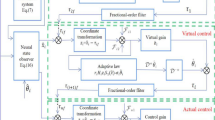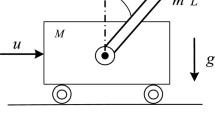Abstract
The adaptive fixed-time control problem for nonlinear systems with time-varying actuator faults is investigated in this paper. A novel adaptive fixed-time controller is designed via combining the Lyapunov stability theory with the backstepping method. It can be adapted to both system uncertainties and unknown actuator faults. Compared with the existing fault-tolerant control schemes subject to actuator faults, the adaptive fixed-time neural networks control scheme can make sure that the tracking error is convergent in a small neighborhood of the origin within a fixed-time interval, and it does not depend on the original states of the system and actuator faults. In light of the control scheme proposed in this paper, the fixed-time stability of the closed-loop system can be guaranteed by theoretical analysis, and a numerical example is provided to verify the effectiveness of obtained theoretical results.











Similar content being viewed by others
Data availability
Data sharing is not applicable to this article as no datasets were generated or analyzed during the current study.
References
Rajamani, R., Hedrick, J.: Adaptive observers for active automotive suspensions: theory and experiment. IEEE Trans. Control Syst. Technol. 3(1), 86–93 (1995)
Gu, G., Sparks, A., Banda, S.: An overview of rotating stall and surge control for axial flow compressors. IEEE Trans. Control Syst. Technol. 7(6), 639–647 (1999)
Samara, P., Fouskitakis, G., Sakellariou, J., Fassois, S.: A statistical method for the detection of sensor abrupt faults in aircraft control systems. IEEE Trans. Control Syst. Technol. 16(4), 789–798 (2008)
Stief, A., Ottewill, J., Baranowski, J., Orkisz, M.: A PCA and two-stage Bayesian sensor fusion approach for diagnosing electrical and mechanical faults in induction motors. IEEE Trans. Ind. Elect. 66(12), 9510–9520 (2019)
Veillette, J.: Reliable linear-quadratic state-feedback control. Automatica 31(1), 137–143 (1995)
Cheng, J., Wang, Y., Park, J.H., Cao, J., Shi, K.: Static output feedback quantized control for fuzzy Markovian switching singularly perturbed systems with deception attacks. IEEE Trans. Fuzzy Syst. (2021). https://doi.org/10.1109/TFUZZ.2021.3052104
Shen, H., Hu, X., Wang, J., Cao, J., Qian, W.: Non-fragile \(\cal{H}_{\infty }\) synchronization for Markov jump singularly perturbed coupled neural networks subject to double-layer switching regulation. IEEE Trans. Neural Netw. Learn. Syst. (2021). https://doi.org/10.1109/TNNLS.2021.3107607
Mushage, B., Chedjou, J., Kyamakya, K.: Observer-based fuzzy adaptive fault-tolerant nonlinear control for uncertain strict-feedback nonlinear systems with unknown control direction and its applications. Nonlinear Dyn. 88(4), 2553–2575 (2017)
Chang, J., Guo, Z., Cieslak, J., Henry, D.: Robust fault accommodation strategy of the reentry vehicle: a disturbance estimate-triggered approach. Nonlinear Dyn. 103(3), 2605–2625 (2021)
Du, M., Zhao, D., Yang, M., Chen, H.: Nonlinear extended state observer-based output feedback stabilization control for uncertain nonlinear half-car active suspension systems. Nonlinear Dyn. 100(3), 2483–2503 (2020)
Zhang, Y., Jiang, J.: Fault tolerant control system design with explicit consideration of performance degradation. IEEE Trans. Aerosp. Elect. Syst. 39(3), 838–848 (2003)
Mathiyalagan, K.: Fault estimator for parabolic systems with distributed inputs and outputs. In: Recent Advances in Control Problems of Dynamical Systems and Networks, vol 457. Springer, Cham, pp 147–167 (2021)
Zhang, X., Parisini, T., Polycarpou, M.M.: Adaptive fault-tolerant control of nonlinear uncertain systems: an information-based diagnostic approach. IEEE Trans. Autom. Control 49(8), 1259–1274 (2004)
Mathiyalagan, K., Sangeetha, G.: Finite-time stabilization of nonlinear time delay systems using LQR based sliding mode control. J. Franklin Inst. 356(7), 3948–3964 (2019)
Wang, J., Yang, C., Xia, J., Wu, Z., Shen, H.: Observer-based sliding mode control for networked fuzzy singularly perturbed systems under weighted try-once-discard protocol. IEEE Trans. Fuzzy Syst. (2021). https://doi.org/10.1109/TFUZZ.2021.3070125
Zhai, D., An, L., Li, J., Zhang, Q.: Adaptive fuzzy fault-tolerant control with guaranteed tracking performance for nonlinear strict-feedback systems. Fuzzy Sets Syst. 302, 82–100 (2016)
Zhang, D., Shen, Z., Song, Y.: Robust adaptive fault-tolerant control of nonlinear uncertain systems tracking uncertain target trajectory. Inf. Sci. 415, 446–460 (2017)
Hao, W., Xian, B.: Nonlinear adaptive fault-tolerant control for a quadrotor UAV based on immersion and invariance methodology. Nonlinear Dyn. 90(4), 2813–2826 (2017)
Niu, J., Chen, F., Tao, G.: Nonlinear fuzzy fault-tolerant control of hypersonic flight vehicle with parametric uncertainty and actuator fault. Nonlinear Dyn. 92(3), 1299–1315 (2018)
Gao, H., Song, Y., Wen, C.: Backstepping design of adaptive neural fault-tolerant control for MIMO nonlinear systems. IEEE Trans. Neural Netw. Learn. Syst. 28(11), 2605–2613 (2017)
Xie, C., Yang, G.: Decentralized adaptive fault-tolerant control for large-scale systems with external disturbances and actuator faults. Automatica 85, 83–90 (2017)
Ma, J., Park, J., Xu, S.: Global adaptive finite-time control for uncertain nonlinear systems with actuator faults and unknown control directions. Nonlinear Dyn. 97(4), 2533–2545 (2019)
Xu, Q., Wang, Z., Zhen, Z.: Adaptive neural network finite time control for quadrotor UAV with unknown input saturation. Nonlinear Dyn. 98(3), 1973–1998 (2019)
Wang, L., Wang, H., Liu, P.X.: Adaptive fuzzy finite-time control of stochastic nonlinear systems with actuator faults. Nonlinear Dyn. 104(1), 523–536 (2021)
Bhat, S., Bernstein, D.: Continuous finite-time stabilization of the translational and rotational double integrators. IEEE Trans. Autom. Control 43(5), 678–682 (1998)
Ding, S., Mei, K., Yu, X.: Adaptive second-order sliding mode control: a Lyapunov approach. IEEE Trans. Autom. Control (2021). https://doi.org/10.1109/TAC.2021.3115447
Du, H., Wen, G., Wu, D., Cheng, Y., Lu, J.: Distributed fixed-time consensus for nonlinear heterogeneous multi-agent systems. Automatica 113, 1–11 (2020)
Wei, W., Zhang, W.: Finite-time adaptive switched gain control for non-strict feedback nonlinear systems via nonlinear command filter. Nonlinear Dyn. 100, 3485–3496 (2020)
Cai, M., Xiang, Z., Guo, J.: Adaptive finite-time control for uncertain nonlinear systems with application to mechanical systems. Nonlinear Dyn. 84(2), 943–958 (2016)
Sakthivel, R., Joby, M., Wang, C., Kaviarasan, B.: Finite-time fault-tolerant control of neutral systems against actuator saturation and nonlinear actuator faults. Appl. Math. Comput. 332, 425–436 (2018)
Xu, P., Li, Y., Tong, S.: Fuzzy adaptive finite time fault-tolerant control for multi-input and multi-output nonlinear systems with actuator faults. Int. J. Control Autom. 17(7), 1655–1665 (2019)
Zhou, X., Gao, C., Li, Z.-G., Ouyang, X.-Y., Wu, L.-B.: Observer-based adaptive fuzzy finite-time prescribed performance tracking control for strict-feedback systems with input dead-zone and saturation. Nonlinear Dyn. 103(2), 1645–1661 (2021)
Esmaeilzadeh, S.M., Golestani, M., Mobayen, S.: Chattering-free fault-tolerant attitude control with fast fixed-time convergence for flexible spacecraft. Int. J. Control Autom. 19(2), 767–776 (2021)
Chen, Z., Wang, Y., Sun, M., Sun, Q.: Convergence and stability analysis of active disturbance rejection control for first-order nonlinear dynamic systems. Trans. Inst. Meas. Control 41(7), 2064–2076 (2019)
Hu, G.: Robust consensus tracking of a class of second-order multi-agent dynamic systems. Syst. Control Lett. 61(1), 134–142 (2012)
Boyan, J., Qinglei, H., Michael, F.: Fixed-time attitude control for rigid spacecraft with actuator saturation and faults. IEEE Trans. Control Syst. Technol. 24(5), 1892–1898 (2016)
Boyan, J., Qinglei, H., Michael, F.: Fixed-time rendezvous control of spacecraft with a tumbling target under loss of actuator effectiveness. IEEE Trans. Aerosp. Electron. Syst. 52(4), 1576–1586 (2016)
Choi, J.Y., Farrell, J.A.: Adaptive observer backstepping control using neural networks. IEEE Trans. Neural Netw. 12(5), 1103–1112 (2001)
Wang, F., Zhang, X.: Adaptive finite time control of nonlinear systems under time-varying actuator failures. IEEE Trans. Syst. Man Cybern. Syst. 49(9), 1845–1852 (2019)
Kale, M.: A: Chipperfield, Stabilized MPC formulations for robust reconfigurable flight control. Control. Eng. Pract. 13(6), 771–788 (2005)
Corradini, M.L., Orlando, G.: Actuator failure identification and compensation through sliding modes. IEEE Trans. Control Syst. Technol. 15(1), 184–190 (2007)
Polyakov, A.: Nonlinear feedback design for fixed-time stabilization of linear control systems. IEEE Trans. Autom. Control 57(8), 2106–2110 (2012)
Qian, C., Lin, W.: Non-Lipschitz continuous stabilizers for nonlinear systems with uncontrollable unstable linearization. Syst. Control Lett. 42(3), 185–200 (2001)
Wang, C., Lin, Y.: Decentralized adaptive tracking control for a class of interconnected nonlinear timevarying systems. Automatica 54, 16–24 (2015)
Zuo, Z., Tie, L.: A new class of finite-time nonlinear consensus protocols for multi-agent systems. Int. J. Control 87(2), 363–370 (2014)
Jin, X.: Adaptive fixed-time control for MIMO nonlinear systems with asymmetric output constraints using universal barrier functions. IEEE Trans. Autom. Control 64(7), 3046–3053 (2019)
Acknowledgements
This work of H. Shen was supported by the NNSFC under Grant Nos. 61873002, 61703004 and 61973199. Also, the work of J.H. Park was supported by the National Research Foundation of Korea (NRF) Grant funded by the Korea government (Ministry of Science and ICT) (No. 2019R1A5A808029011).
Author information
Authors and Affiliations
Corresponding author
Ethics declarations
Conflict of interest
The authors declare that they have no conflict of interest.
Additional information
Publisher's Note
Springer Nature remains neutral with regard to jurisdictional claims in published maps and institutional affiliations.
Supplementary Information
Below is the link to the electronic supplementary material.
Appendix
Appendix
Consider the Lyapunov function as follows:
According to the definition of \(\tilde{\theta }_{i}\), one can get the following inequality:
and motivated by the literature [46], just to facilitate the description of the binomial theorem \(\left( \theta _{i}-\tilde{\theta } _{i}\right) ^{3}\), \(p=3/4\) and \(q=2\) are used to demonstrate stability. Based on (49), (50), Lemmas 5 and 6, then the time derivative of \(V_{m}\) is
where \(\bar{\varrho }_{1}=\min \left( c_{1,1},\ldots ,c_{m,1},\bar{\psi }_{1},\ldots , \bar{\psi }_{m}\right) \), \(\bar{\varrho }_{2}=\min \left( c_{1,2},\ldots ,c_{m,2}\right) \).
Applying Lemma 2 to the term \(\left( \frac{\bar{\psi }_{i}\tilde{\theta } _{i}^{2}}{2b_{i}}\right) ^{\gamma }\), we can obtain that
Combining (52) and (51), one has
where \(\tilde{\nu }=\sum _{i=1}^{m}\frac{\bar{\psi }_{i}\theta _{i}^{2}}{b_{i}} +\left( 1-\gamma \right) \gamma ^{\frac{\gamma }{1-\gamma }}+\Delta _{m}\). Similar to (50), (53) can be expressed as
Applying Young’s inequality [46] to terms \(\sum _{i=1}^{m} \frac{3c_{i}\theta _{i}\tilde{\theta }_{i}^{3}}{b_{i}^{2}}\) and \( \sum _{i=1}^{m}\frac{c_{i}\theta _{i}^{3}\tilde{\theta }_{i}}{b_{i}^{2}}\), one has
Combining (55), (56) with (54) yields
where \(\nu =\tilde{\nu }+\sum _{i=1}^{m}\frac{3c_{i}\theta _{i}^{4}}{4\iota ^{4}b_{i}^{2}}+\sum _{i=1}^{m}\frac{c_{i}\theta _{i}^{4}}{12b_{i}^{2}}\). Moreover, (57) can be rewritten as:
where \(\hat{\varrho }_{2}=\min \left( \left( 4-9\iota ^{\frac{4}{3}}\right) c_{i},\frac{\bar{\varrho }_{2}}{m}\right) \); we can get
Applying Lemmas 4 and 5 to \(\dot{V}_{m}\), one can get
where \(\varrho _{2}=\hat{\varrho }_{2},\varrho _{1}=\bar{\varrho }_{1}\).
At the same time, it follows from (60) that
where \(0<\varpi <1\). If \(\nu -(1-\varpi )\varrho _{1}V_{m}^{2}<0\), by Lemma 1, one can obtain
It also follows from (60) that
where \(0<\varpi <1\). If \(\nu -(1-\varpi )\varrho _{2}V_{m}^{2}<0\). By applying Lemma 1, it follows
By using Lemma 1, that the system is FTS can be obtained and one can get
According to the definition of \(V\left( x\right) \), it can be concluded that, for \(\Xi \triangleq (2\varrho _{1}^{-\frac{1}{2p}}(\frac{\nu }{ 1-\varpi })^{\frac{1}{2p}})\), \(\mid z_{j}\mid \le \Xi \), and \(\mid y-y_{d}\mid \le \Xi \). In other words, the output can track the desired signal \(y_{d}\) to a small neighborhood in fixed time. On the basis of (60), it is not hard to derive that \(\dot{V}_{m}<0\), when \(V_{m}^{2}\ge \nu /\varrho _{2}\). Obviously, it can be observed that all the state variables \(x_{j}\) are bounded. This completes the proof.
Rights and permissions
About this article
Cite this article
Mei, Y., Wang, J., Park, J.H. et al. Adaptive fixed-time control for nonlinear systems against time-varying actuator faults. Nonlinear Dyn 107, 3629–3640 (2022). https://doi.org/10.1007/s11071-021-07171-y
Received:
Accepted:
Published:
Issue Date:
DOI: https://doi.org/10.1007/s11071-021-07171-y




